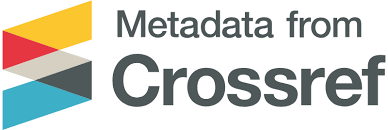Pengaruh Intrapreneurship Terhadap Inovasi Berkelanjutan
Keywords:
Intrapreneurship, Inovasi BerkelanjutanAbstract
Usaha skala kecil dan menengah (UKM) ditantang untuk dapat mengadaptasi inovasi berkelanjutan ke dalam rutinitas operasional produksi dalam upaya mencapai pembangunan berkelanjutan yang berdampak pada aspek ekonomi, lingkungan, dan sosial. Walaupun implementasi inovasi berkelanjutan memerlukan investasi teknologi dengan nilai yang cukup besar seperti yang dilakukan oleh industri berskala besar, namun, UKM dapat memanfaatkan kemampuan internal yang merupakan kemampuan spesifik perusahaan sesuai dengan sumber daya yang dimiliki. Penelitian ini bertujuan mengukur secara empiris peran intrapreneurship perusahaan sebagai kemampuan dinamis dalam memberikan pengaruh terhadap pencapaian inovasi berkelanjutan. Dengan analisis regresi linear sederhana, hasil penelitian menunjukkan bahwa kemampuan intrapreneurship perusahaan berpengaruh signifikan terhadap pencapaian inovasi berkelanjutan.
Downloads
References
Achterkamp, M.C., Vos, J.F.J. (2006). A framework for making sense of sustainable innovation through stakeholder involvement. International Journal of Environmental Technology and Management. 6(6), 525-538.
Amo, B. W., Kolvereid, L. (2005). Organizational strategy, individual personality and innovation behavior. Journal of Enterprising Culture, 13(1), 7-19.
Antoncinc, B., Hisrich, R. D. (2001). Intrapreneurship: Construct refinement and crosscultural validation. Journal of Business Venturing, 16, 495 – 527.
Arief, M., Thoyib, A., Sudiro, A., Rohman, F. (2013). The effect of entrepreneurial orientation on the firm performance through strategic flexibility: A study on the SMEs cluster in Malang. Journal of Management Research, 5(3), 44.
Arundel, A., Kemp, R., Parto, S. (2006). 21 Indicators for environmental innovation: what and how to measure. The international handbook on environmental technology management, 324.
Barney, J. B. (1991). Firm resources and Sustained Competitive Advantage. Journal of Management, 17, 99–120.
Bartlett, II., J. E., Kotrlik, J. W., Higgins, C. C. (2001). Organizational Research: Determining Appropriate Sample Size in Survey Research Appropriate Sample Size in Survey Research. Information Technology, Learning, and Performance Journal, 19(1), 43-50
Bennis, W., Nanus, B. (1985). Leaders: The Strategies for Taking Charge. Harper and Row, New York, NY.
Burgelman, R. A. (1983). Corporate entrepreneurship and strategic management: Insights from a process study. Management Science, 29(12), 1349-1364.
Chandra, W. (2016). Tercemar Berat, Pesisir Makassar Tak Lagi Kondusif. Retrieved on 13/05/2019 at http://www.mongabay.co.id/2016/09/25/tercemar-beratpesisir-makassar-tak-lagi-kondusif/
Coakes, E. W., Smith, P. A., Alwis, D. (2011). Sustainable innovation and right to market. Information Systems Management, 28(1), 30-42.
Cohendet, P., Llerena, P. (2005). A dual theory of the firm between transactions and competences: conceptual analysis and empirical considerations. Revue D'économie Industrielle, 110(1), 175-198.
Covin, J. G., and Slevin, D. P. (1986). The development and testing of an organizational-level entrepreneurship scale. Frontiers of Entrepreneurship Research, 1(1986), 626-639.
Cronbach L.J. (1951). Coefficient alpha and the internal structure of tests. Psychometrika, 16, 297-333.
Cunningham, J. B., Lischeron, J. (1991). Defining entrepreneurship. Journal of Small Business Management, 29(1), 45-61.
Dyllick, T., Hockerts, K. (2002). Beyond the business case for corporate sustainability. Business Strategy and the Environment, 11(2), 130-141.
Easterby‐Smith, M., Prieto, I. M. (2008). Dynamic capabilities and knowledge management: an integrative role for learning?. British Journal of Management, 19(3), 235-249.
Eisenhardt, K. M., Martin, J. A. (2000). Dynamic capabilities: what are they?. Strategic Management Journal, 21(10-11), 1105-1121.
EPI. (2018). Global Metrics for the Environment: Ranking Country Performance on High-Priority Environmental Issues. Columbia University.
Ghozali, I. (2009). Model persamaan struktural. Konsep dan aplikasi dengan program Amos 16.0. Semarang: Badan Penerbit Universitas Dipenogoro.
GII. (2018). Energizing the World with Innovation. Cornell SC Johnson College of Business.
Haluan Harian (Sabtu, 07 Mei 2016). UMKM Tak Mampu Bayar UMP. Retrieved on 28/11/2016 at http://harianhaluan.com/mobile/detailberita/53074/umkm-takmampu-bayar-ump.
Helfat, C. E., Winter, S. G. (2011). Untangling dynamic and operational capabilities: Strategy for the (N) ever‐changing world. Strategic management journal, 32(11), 1243-1250.
Iles, A., Martin, A. N. (2013). Expanding bioplastics production: sustainable business innovation in the chemical industry. Journal of Cleaner Production, 45, 38-49.
Jones, G.R., Butler, J.E. (1992). Managing internal corporate entrepreneurship: an agency theory perspective. Journal of Management, 18(4), 733-49.
Keizer, J. A., Dijkstra, L., Halman, J. I. (2002). Explaining innovative efforts of SMEs.: An exploratory survey among SMEs in the mechanical and electrical engineering sector in The Netherlands. Technovation, 22(1), 1-13.
Ketata, I., Sofka, W., Grimpe, C. (2014). The role of internal capabilities and firms' environment for sustainable innovation: evidence for Germany. R&D Management, 1-16.
Kusumawardhani, A. (2013). The role of entrepreneurial orientation in firm performance: a study of Indonesian SMEs in the furniture industry in Central Java. Thesis of Wollongong University.
Lewis, M., Young, B., Mathiassen, L., Rai, A., Welke, R. (2007). Business process innovation based on stakeholder perceptions. Information Knowledge Systems Management, 6(1, 2), 7-27.
Lumpkin, G. T., Dess, G. (1996). Clarifying the entrepreneurial orientation construct and linking it to performance. Academy of Management Review, 21(1), 135–172.
MacMillan, I. C., Block, Z., Narasimha, P. S. (1986). Corporate venturing: alternatives, obstacles encountered, and experience effects. Journal of Business Venturing, 1(2), 177-191.
Monnavarian, A., Ashena, M. (2009). Intrapreneurship: the role of social capitalempirical evidence and proposal of a new model of intrapreneurship and its relationship with social capital. Business Strategy Series, 10(6), 383-399.
Nelson, R. R. (1994). The role of firm difference in an evolutionary theory of technical advance. In Magnusson L. (ed.). Evolutionary and Neo-Schumpeterian Approaches to Economics, Kluwer, Dordrecht.
OECD. (2008). Economic Assessment of Biofuel Support Policies. Directorate for Trade and Agriculture, OECD, Paris. Press Conference, Paris, 16th July 2008. <http://www.oecd.org/dataoecd/54/10/40990370.pdf>.
Paulraj, A. (2011). Understanding the Relationship Between Internal Resources and Capabilities, Sustainable Supply Management and Organizational Sustainability. Journal of Supply Chain Management, 47(1), 19-37.
Pierce, D. W., Atkinson, G. D. (1993). Capital theory and the measurement of sustainable development: an indicator of “weak” sustainability. Ecological Economics, 8, 103-108.
Pinchot, G. (1985). Intrepreneuring. Harper and Row Publisher, New York, NY.
Porter, M. E., van der Linde, C. (1995). Green and Competitive: Ending the Stalemate. Harvard Business Review, 73(5), 120–134.
Porter, M.E. (1996). What is strategy. Harvard Business Review, 74 (6), 61–78.
Raziq, A., Wiesner, R. (2016). High Performance Management Practices and Sustainability of SMEs. Evidence from Manufacturing and Services-based Industries in Pakistan. Journal of Management Sciences, 3(2), 83-107.
Samoedra, A. D. A., Setiawan, H. (2015). The Influence of Entrepreneurship Orientation on Organizational Learning, Sustainable Competitive Advantage, and Company Performance at Small and Medium Enterprises in West Java. Global Journal of Business and Social Science Review, 14(1), 117-124.
Schumpeter, J. (1942). Creative destruction. Capitalism, socialism and democracy, 82-5.
Seebode, D. (2011). Sustainable Innovation: Exploring a New Innovation Paradigm. Royal Philips Electronics NV, Amsterdam.
Sharma, S., Vredenburg, H. (1998). Proactive Environmental Strategy and the Development of Competitively Valuable Organizational Capabilities. Strategic Management Journal, 19(8), 729–753.
Stevenson, H.H., and Jarillo, J.C. (1990). A paradigm of entrepreneurship: Entrepreneurial management. Strategic Management Journal, 11,17–27.
Stopford, J.M., Baden-Fuller, C. (1990). Corporate rejuvenation. Journal of Management Studies, 27(4), 399-415.
Sugiyono. (2012). Metode Penelitian Kuantitatif Kualitatif dan R&D. Bandung: Alfabeta.
Teece, D., Pisano, G., Shuen, A. (1997) Dynamic capabilities and strategic management. Strategic Management Journal, 18, 7, 537–556.
Tribunnews.com. (Jumat, 7 Oktober 2016). Bau busuk, ratusan warga demo pabrik karet Mojokerto. Retrieved on 15/05/2019 at http://surabaya.tribunnews.com/2016/10/07/bau-busuk-ratusan-warga-demopabrik-karet-mojokerto.
Uddin, M.K. (2006), The role of diffusion of innovations for incremental development in small enterprises. Technovation, 26(2), 274-284.
Urban, B. (2012). The effect of pro-entrepreneurship architecture on organisational outcomes. Journal of Business Economics and Management, 13(3), 518-545.
Venkatraman, N. (1989). Strategic Orientation of Business Enterprises: The Construct, Dimensionality, and Measurement. Management Science, 35(8), 942-962.
WBCSD. (2010). Vision 2050. Geneva: WBCSD.
WCED. (1987). Our Common Future. The World Commission on Environment and Development, Oxford Univ. Press, Oxford and New York, 400.
Westley, F., Vredenburg, H. (1991). Strategic bridging: The collaboration between environmentalists and business in the marketing of green products. Journal of Applied Behavioral Science, 27, 65–91.
Zhu, Q., and Sarkis, J. (2004). Relationships between operational practices and performance among early adopters of green supply chain management practices in Chinese manufacturing enterprises. Journal of Operations Management, 22(3), 265-289.
Downloads
Published
How to Cite
Issue
Section
License

This work is licensed under a Creative Commons Attribution-NonCommercial-NoDerivatives 4.0 International License.










